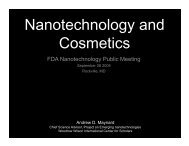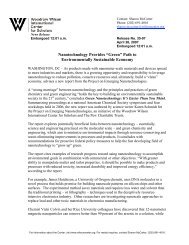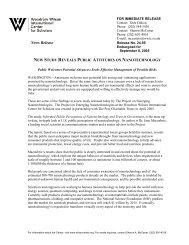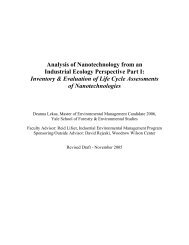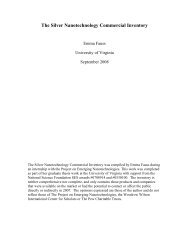nanotechnology oversight - Project on Emerging Nanotechnologies
nanotechnology oversight - Project on Emerging Nanotechnologies
nanotechnology oversight - Project on Emerging Nanotechnologies
You also want an ePaper? Increase the reach of your titles
YUMPU automatically turns print PDFs into web optimized ePapers that Google loves.
18<br />
mulated a detailed framework for examining<br />
the health and envir<strong>on</strong>mental effects of a<br />
nanoproduct. The framework (see Figure 2)<br />
was tested <strong>on</strong> several products made or used<br />
by DuP<strong>on</strong>t, and DuP<strong>on</strong>t has made its use<br />
mandatory in the development of new<br />
nanoscale materials within the company.<br />
The framework should be embraced by the<br />
NanoBusiness Alliance and be incorporated<br />
into the Resp<strong>on</strong>sible Care program of the<br />
American Chemistry Council. The Department<br />
of Commerce could meet with these<br />
organizati<strong>on</strong>s and encourage them to use the<br />
framework.<br />
In additi<strong>on</strong>, the insurance industry should<br />
c<strong>on</strong>sider making adopti<strong>on</strong> of the framework a<br />
c<strong>on</strong>diti<strong>on</strong> for insuring nanomanufacturers.<br />
The insurance industry has, for the past several<br />
years, shown leadership in expressing c<strong>on</strong>cern<br />
about the potential adverse effects of <str<strong>on</strong>g>nanotechnology</str<strong>on</strong>g>.<br />
Important reports about nano<br />
have been issued by Swiss Re (2004) and by<br />
Lloyd’s (2007). The new administrati<strong>on</strong><br />
should meet with insurers and perhaps with<br />
state insurance regulators to explore how the<br />
insurers can best deal with nano and how the<br />
federal government could support their efforts.<br />
2. Issue a <str<strong>on</strong>g>nanotechnology</str<strong>on</strong>g> handbook<br />
for small businesses. Many of<br />
the companies involved with <str<strong>on</strong>g>nanotechnology</str<strong>on</strong>g><br />
are small start-up companies, often springing<br />
from university research efforts. These companies<br />
need help in thinking about testing<br />
requirements, legal c<strong>on</strong>straints and life-cycle<br />
analysis of <str<strong>on</strong>g>nanotechnology</str<strong>on</strong>g> products. There<br />
also may be opportunities for encouraging<br />
small companies to invest in green nano. The<br />
Small Business Administrati<strong>on</strong>, working with<br />
EPA and trade associati<strong>on</strong>s, should produce<br />
and disseminate a handbook dealing with<br />
these matters. The handbook should be<br />
aimed at small <str<strong>on</strong>g>nanotechnology</str<strong>on</strong>g> firms and<br />
should be available <strong>on</strong> the Internet.<br />
PUBLIC INVOLVEMENT<br />
The basic problem with public involvement is<br />
the scarcity of people who want to listen.<br />
Most officials do not really want to listen to<br />
the public, most members of the public are<br />
not really interested in listening to officials or<br />
experts, and representatives of interest groups<br />
are much more interested in being heard than<br />
in listening. One of the great virtues of democratic<br />
electi<strong>on</strong>s is that they give politicians an<br />
incentive to listen to the public. The listening<br />
problem will not be fixed in 100 days, and<br />
probably not in 100 years, but there are steps<br />
that can and should be taken to involve the<br />
public in <str<strong>on</strong>g>nanotechnology</str<strong>on</strong>g> policy.<br />
*1. Give the public more informati<strong>on</strong><br />
about <str<strong>on</strong>g>nanotechnology</str<strong>on</strong>g>. More<br />
than three-quarters of the American public<br />
know almost nothing about <str<strong>on</strong>g>nanotechnology</str<strong>on</strong>g>.<br />
There is no guarantee that knowing more<br />
about the technology will make the public<br />
more supportive of it (Kahan, et al. 2008), but<br />
knowing more could make their views more<br />
reas<strong>on</strong>ed and less subject to bias and misinformati<strong>on</strong>.<br />
The Nati<strong>on</strong>al Science Foundati<strong>on</strong><br />
(NSF) has invested in museum programs and<br />
other methods of informing the public about<br />
<str<strong>on</strong>g>nanotechnology</str<strong>on</strong>g>, and it should increase its<br />
efforts, using televisi<strong>on</strong>, the Internet and other<br />
appropriate media. NSF should also c<strong>on</strong>sider<br />
working with organizati<strong>on</strong>s such as America<br />
Speaks, which have experience in engaging the<br />
public <strong>on</strong> important policy issues.<br />
Two more specific ways of informing the<br />
public are labeling and use of the Toxics<br />
Release Inventory (TRI). Some c<strong>on</strong>sumer




